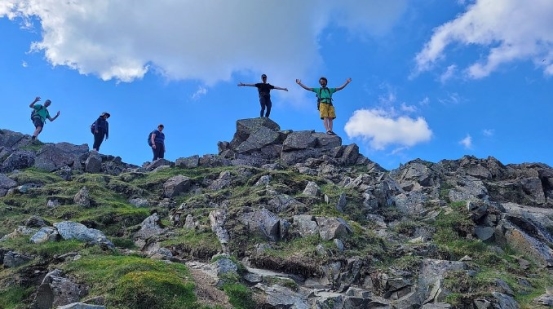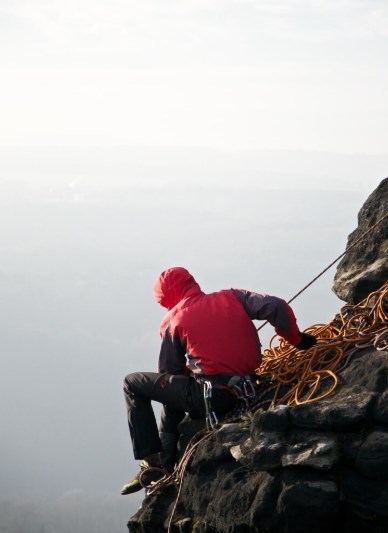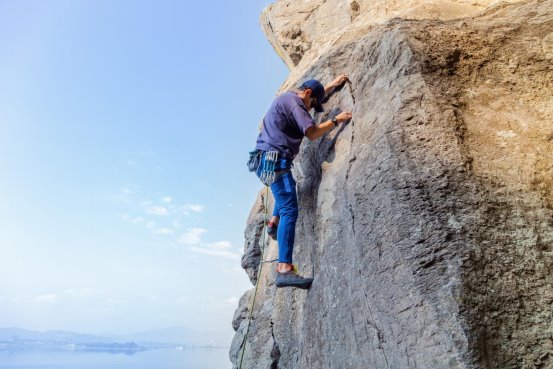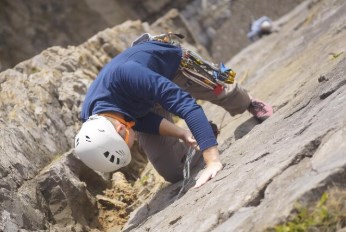How to Overcome the Fear of Heights

According to a 2023 YouGov survey, 23% of Britons reported suffering from acrophobia (fear of heights). Perhaps you are one of them?
For hillwalkers keen to try scrambling, or indoor climbers venturing onto uncertain real rock and hard landings outdoors, fear can be a major barrier.
But the good news is, it can be overcome through exposure therapy and mindfulness practice. While this fear is rooted in our natural survival instinct, through exposure therapy and mindfulness, the fear can be managed and even conquered.

I. What is Acrophobia?
Acrophobia is the fear of heights. More specifically, it is an irrational and extreme fear of heights. Someone experiencing a panic attack on an escalator on the London Underground or in the cheap seats of a stadium isn’t rationally afraid of heights; they are gripped by an extreme fear. That is acrophobia.
II. What is Vertigo, and is it the Same as Fear of Heights?
Vertigo is most commonly a symptom of an inner ear problem, but can also stem from brain issues or infections. Vertigo feels like you or everything around you is spinning – enough to affect your balance. It’s often a short-term issue and doesn’t always require treatment. It’s frequently mentioned by those with acrophobia, but vertigo is not the same as acrophobia or fear of heights.

III. Recognizing the Signs and Symptoms of Acrophobia
Symptoms of acrophobia vary from person to person but generally follow a similar pattern.
I always enjoyed climbing, but when I was afraid of heights, I made no progress at all.
When we sense danger, a small part of the brain called the amygdala activates. This is the part of the brain that triggers the “fight or flight” mechanism.
When we feel threatened, our body prepares for action (fight or flight).
Our major muscle groups need oxygenated blood, require more glucose, and to prevent overheating, we need to start sweating.
What we might then experience/observe includes:
- Increased heart rate and elevated blood pressure
- Rapid, shallow breathing
- Sweating / sweaty palms
- Loss of peripheral vision and situational awareness
- Loss of the ability to process information
In short: our brain is hijacked by the amygdala, and we lose the capacity for rational thought.

IV. What Causes Acrophobia, and Why Are People Afraid of Heights?
As a species, we are inherently wary of heights because it helped us survive.
Imagine a cavewoman waking early one morning, stepping out of her cave, scratching her back, and seeing a tiger. If she said, “I’m going to fight you!”, we did not evolve from that cavewoman!
It’s evolution. Those ancient ancestors survived long enough to pass their genes on to modern humans because they were good at running away.
Our amygdala exists for good reason. However, for some people – like those of us with acrophobia – it simply becomes oversensitive.
As we age, we tend to become more risk-averse – some might call it wiser. But the good news is we also become skilled through practice.
The more we practice, the better we become at managing fear, and the more likely we are to avoid any fear-inducing stimulus.
The reason we fear heights (acrophobia) might be that our parents modeled this fear for us, or because we had a past traumatic experience that causes us to feel fear now.

V. What is the Best Treatment for Acrophobia, and How is Fear of Heights Treated?
To overcome a fear of heights, you need to gradually and progressively expose your brain to new challenges.
This is known as expanding your comfort zone. Typically, this process is referred to as Cognitive Behavioural Techniques (CBT) or Exposure Therapy.
By accepting small challenges, we can step out of our comfort zone and ideally into what’s termed the Zone of Proximal Development.
If we over-challenge ourselves (“kill or cure”), we will have a negative experience and worsen the situation.
If we never step out of our comfort zone, we gradually become adept at reinforcing the current negative narrative and worsening the situation.
The key is to find a balance between these two extremes.
Positive change is easier said than done.
After all, you have a phobia of heights! Like losing weight, we all know the theory, but putting it into practice can be challenging. Resolving a height phobia requires conscious effort.
As with weight loss techniques, we may benefit from expert guidance if we want to make progress.
In short, you need to find a series of exercises to provide your brain with positive feedback. And gradually, incrementally increase the challenge, ideally changing only one variable at a time. This will help you alter the narrative currently running in your brain.

VI. Are There Natural Remedies for Fear of Heights?
If you’re hoping to find a pill at your local health food store to overcome acrophobia, you’ll likely be disappointed!
While what we can’t ingest can help, there are other natural approaches that might benefit you. Here I’m referring to meditation and learning to be present in the moment.
Meditation and visualization techniques for learning how to stay calm at height help us manage our thought processes.
This helps us take proactive measures before a situation arises, rather than reacting passively afterward.
This is also one reason we use hypnotherapy in our courses.
Through meditation or simply visualization, we are actively preparing for potentially stressful situations.
Even seemingly simple actions like watching others climb can help our brain figure out how we might do it too.
VII. Moving Forward
Overcoming acrophobia is a journey. It requires patience, some persistence, and the right guidance.
While acrophobia is rooted in our natural survival instinct, it can be managed and even overcome through exposure therapy (CBT) and mindfulness practice.
By progressively expanding our comfort zone and challenging fearful thoughts, we can regain control and embrace new experiences without being held back by fear.
While the process can be difficult, seeking professional support can make a significant difference. With the right approach, it’s possible to replace fear with confidence and enjoy heights that once seemed insurmountable.








































